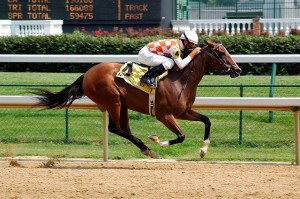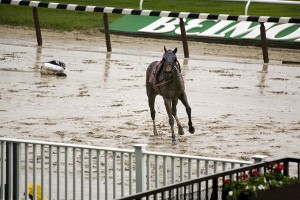Musculoskeletal injuries are the most commonly seen injuries in racehorses. Of these kinds of injuries, fractures are extremely prevalent. In one study that examined the causes of equine death on California racetracks, it was shown that musculoskeletal injuries accounted for 83% of deaths [1]. However, while injuries and fatalities during races are usually quite public, there is also a concern about the rate of injuries during training as well. One study found that for every racecourse fatality, there was also a fatality that occurred during training gallops [2].
There are many factors that increase the risk of fracture. A few examples are: training programs, turf versus dirt tracks, and age of the horse.
Horses that had done little to no gallop work during training, as well as those horses that were in their first year of racing, were found to be at an increased risk of fracture [3].  Traditional training consists mainly of long distances of slow speed exercise, which is very different from an actual race, so it is thought that this kind of training does not adequately “prepare” the bones for racing [4].
Traditional training consists mainly of long distances of slow speed exercise, which is very different from an actual race, so it is thought that this kind of training does not adequately “prepare” the bones for racing [4].
Track surface is also an important factor.There are three main kinds of racing surfaces that are used: turf, dirt, and synthetic (“all weather surfaces”)[5]. Turf is used in the United Kingdom and in Australia, while the majority of racecourses in the United States are dirt tracks. Death rates tend to be lower in races on turf compared with races on non-turf (dirt or synthetic), which is consistent with mortality rates being lower in the UK and Australia than in North America[5]. One reason why turf tracks might be safer is that when running on a non-turf track, ˝the hoof slides further before stopping, increasing the degree of fetlock extension as the leg becomes the predominant weight-bearing limb, placing greater strain on the suspensory apparatusˮ (Parkin et al. 2004)[6].
There have been a few studies that have found an increased risk of muscular-skeletal injury to be associated with an increase in age [7,8]. One study found that horses over the age of 4 were 1.8 times more likely to suffer an injury when compared with horses that were younger than 4 years of age [8].
Sources
- Johnson, B. J., Stover, S. M., Daft, B. M., Kinde, H., Read, D. H., Barr, B. C., Anderson, M., Moore, J., Woods, L., Stoltz, J. and Blanchard, P. 1994. Causes of death in racehorses over a 2 year period. Equine Vet J 26: 327-330
- Verheyen KLP. 2005. Epidemiology of fractures in Thoroughbred racehorses in training in the United Kingdom. The Royal Veterinary College. Available at: http://scholar.googleusercontent.com/scholar?q=cache:KVacJO7Jux0J:scholar.google.com/+EPIDEMIOLOGY+OF+FRACTURES+IN+THOROUGHBRED+RACEHORSES+IN+TRAINING+IN+THE+UNITED+KINGDOM&hl=en&as_sdt=0,5&as_vis=1. Accessed April 1st, 2012.
- Clegg PD. 2011. Review article: HBLB’s advances in equine veterinary science and practice- Musculoskeletal disease and injury, now and in the future. Part 1: Fractures and fatalities. Equine Vet J 43: 643-649.
- Nunamaker, D. M. 2002. On bucked shins. Annual Convention of the American Association of Equine Practitioners, 76-89.
- Clarke AF. 2009. Review of safety of turf versus non-turf (synthetic and dirt) racing surfaces. AAEP Proceedings 55:183-186.
- Parkin TDH, Clegg PD, French NP, et al. 2004. Race and course level risk factors for fatal distal limb fracture in racing Thoroughbreds. Equine Vet J 36:521 – 526.
- Williams RB, Harkins, LS, Hammond, CJ and Wood, JL. 2001. Racehorse injuries, clinical problems and fatalities recorded on British racecourses from flat racing and National Hunt racing during 1996, 1997 and 1998. Equine Vet J 33: 478-86.
- Bailey CJ, Reid SWJ, Hodgson DR, Suann CJ, and Rose RJ. 1997. Risk factors associated with musculoskeletal injuries in Australian Thoroughbred racehorses. Preventive Veterinary Medicine 32: 47-55.

